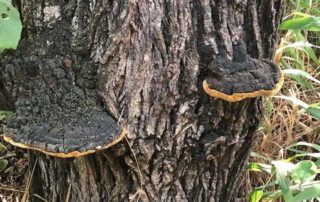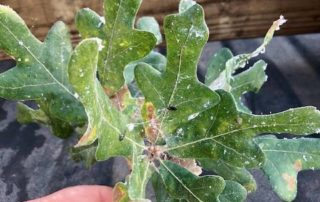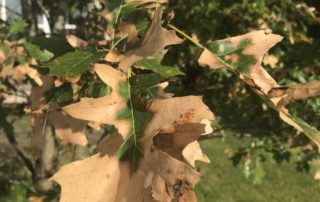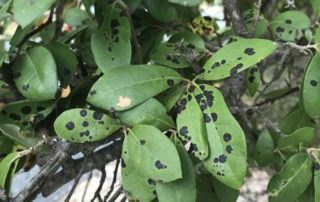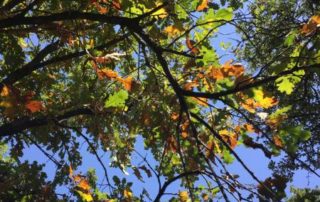Our Tree Care Services Cedar Park, TX
Here at Good Guys Tree Services we truly care about the health and well-being of your trees. With over 20 years industry experience we like to consider ourselves the foremost tree doctors in Cedar Park, with a team of highly skilled arborists providing the highest quality tree care services.
Services We Provide As Tree Doctors Who Care
- Chlorosis & Other Mineral Deficiencies
- Conks, Cankers, Brackets & Armillaria growths
- Fungal Infections
- Wound Care
- Bacterial Infections
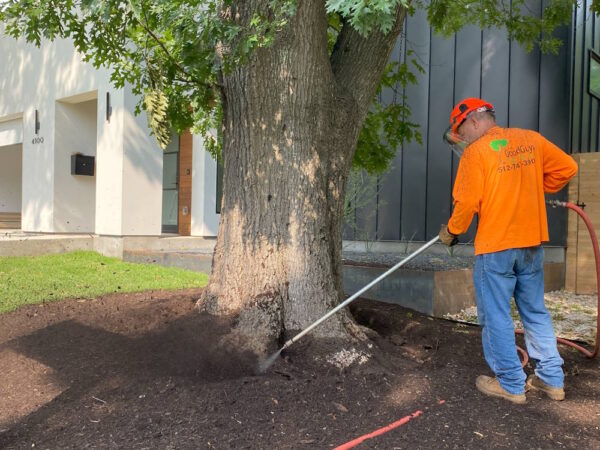
Chlorosis and Other Mineral Deficiencies – Common Issues Impacting Tree Health in Cedar Park
Trees require a unique balance of minerals and nutrients to properly thrive, and unfortunately the climate here in Cedar Park often makes this difficult. Trees in this area commonly suffer from various mineral deficiencies, with chlorosis (iron deficiency) being an especially prominent problem.
How to Tell if Your Tree Has Chlorosis
The most obvious sign that your tree is suffering from a mineral deficiency such as chlorosis is a lack of vibrancy in the leaves. Instead of looking a rich green tone, leaves take a lighter green hue, often bleaching to the point of yellowing.
So, if your leaves look too light a green or are even yellowing, then there is a good chance it is anaemic and suffering from chlorosis. Other deficiencies include manganese and zinc, which causes leaves to become blotchy and underdeveloped.
Treatment Options
We offer direct mineral injection into the tree. This specially formulated solution is quickly absorbed into the trees vascular system, producing fast results in as little as four weeks. Another possible method is a soil treatment to ensure proper nutrient and pH levels that encourage healthy root development, which in turn helps promote better mineral absorption to avoid future deficiency issue.
Good Guys Tree Service provides certified arborist consultations, full treatment programs and complete tree maintenance services. Contact us today to schedule an appointment!
Fungal & Bacterial Infections That Truly Require a Tree Doctor
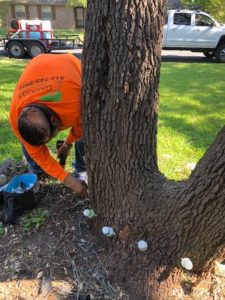 Fungal and bacterial infections are some of the most common issues for trees here in Cedar Park.
Fungal and bacterial infections are some of the most common issues for trees here in Cedar Park.
Identifying the fungal or bacterial infection in your tree is challenging because there are so many possible infections, which is why it helps to know what to look for.
How to Tell If Your Tree has a Fungal Infection
Fungal infections can cause tree leaves to become spotted, streaked, moldy, or warped, while twigs on outer branches often become appear dead at the tips.
Treatment Options
All tree fungal infections are treated with a systemic fungicide injection or spray that helps to contain and control the spread of the disease. We may need to prune some of the tree to avoid future infection.
How to Tell If Your Tree has a Bacterial Infection
Bacterial infections are common amongst fruiting trees in Cedar Park. There are common signs to look out for on the leaves such as blight, scorching, shriveling, or burnt tips. Another easy to determine if a tree has bacterial infection is to check around any wound for black ooze.
Root rot is another symptom but harder to spot (although we can dig part of the root if needed) while general poor tree health like wilting is another common sign there could be a bacterial infection.
Treatment Options
Treating a bacterial infection is not always easy as there are various environmental factors that may be causing the issue, each one requiring a different treatment. For example, if insects are the cause of the problem then we apply an insecticide, root rot requires improved drainage around the roots, and bacterial infection tree canopies may need pruning to improve airflow and stop the spread.
After these environment treatments have been addressed, we may consider antibiotics or immune system elicitor to aid with the recovery.
Contact us for more information on possible treatment options!
Tree Growths – Conks Cankers, Brackets, and Armillaria
Growths are a big problem for many trees in Cedar Park. These are easy to spot, with obvious irregular shaped growths protruding from parts of the tree, possibly accompanied by fungal pads.
A type of fungi, these growths are not much of an issue if found on the branches of the tree, usually growing from a damaged or dead part of the tree. While unsightly they don’t cause any risks to your tree’s long-term health.
However, if a growth is present on the tree trunk then it may be a serious problem. In fact, there is no effective treatment should growths be found on the tree trunk, as this indicates dead wood inside is feeding the fungus and cannot be permanently stopped.
Unfortunately, tree removal is the only option if this type of fungal infection occurs on the trunk. If found on upper branches we may stop the spread with pruning, but anything on the lower trunk and side of the tree will require removal. If left, the tree becomes so weakened that it is eventually to unstable to remain safe.
We will conduct a thorough assessment of any tree growth in Cedar Park to determine the extent of the infection and any possible treatments.
Tree Wound Care
Trees face all kinds of natural wear and tear, so it is natural for them to suffer from various wounds over their course of their lives. From insects to extreme weather conditions to human activity, there are many factors at play that can cause tree wounds like broken and cracked limbs.
Anything larger than 20% of the tree is considered a severe wound and may require specific treatment.
Treatment Options
Treatments for wounds are surprisingly straight-forward. Trees with broken limbs simply need the damaged parts pruned off, while an open wound on the trunk or branches should just be left to heal as an open wound.
Trees repair themselves better than we ever could, so its mostly a case of providing the best conditions for the tree to take care of itself. In some extreme cases, we may recommend a treatment to encourage healthier regrowth, although this is mainly needed for extreme damage.
Insect Infestation
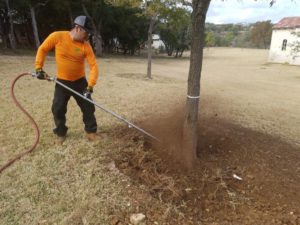 Trees provide natural home for all kinds of insects. While they all play an important part of the local ecosystem, they often cause problems if left unchecked for too long. Common insect issues on trees in Cedar Park include:
Trees provide natural home for all kinds of insects. While they all play an important part of the local ecosystem, they often cause problems if left unchecked for too long. Common insect issues on trees in Cedar Park include:
- Leaves: Most trees have insects nibbling and living around the leaves. They should not cause any problems in most cases, although if your canopy loses around 10-15% from insect activity it is considered a major problem and may require treatment.
- Woods: If there is sawdust around the base of the tree or lots of woodpecker holes, there is a good chance the bark in infected with beetle larva. Another common sign is large portions of bark missing, or even the loss of entire limbs.
- Roots: Some insects cause damage to the root system of the tree. This is harder to spot because you can’t see the insects themselves, although if the tree is displaying slow growth and general poor health like dehydration then it may be a root related infestation.
Treatment Options
This depends on the problem although most are easy to treat using insecticides. There are various products available to treat different infestations, including soil drenches and injections, while we may recommend treatments to encourage good recovery and regrowth.
The biggest challenge with insect infestations is identifying the problem – our qualified arborists will quickly determine the problem and provide necessary solutions!
Soil Compaction
Soil compaction is a massive issue for trees throughout Cedar Park. Given that the root system makes up around half of the tree, if the soil conditions are not right it will cause various problems for any tree.
This includes poor drainage so a lack of water reaches the roots, causing root systems to become underdeveloped and less efficient at delivering key nutrients. Slowly but surely, this causes the tree to become suffocated to the point of death – and you may not even see it coming!
Soil compaction occurs from heavy foot traffic around the tree, so there are many reasons this can happen to your tree, from the kids playing around it to your mower constantly going over the area. Regardless, the problem requires a two-pronged attack to successfully treat!
Treatment Option
- The first treatment for soil compaction is called vertical mulching. This perforates compacted soil to allow water to again reach the entire root system. We use a special auger for this process, allowing us to drill to the right depth and width without damaging the roots.
- These holes are then filled with a combination of pea gravel and peat most to prevent it refilling with dirt, ensuring better drainage going forward.
- After this, we create a lightly mulched and bordered landscaping bed at the base of the tree to avoid future compaction. If the tree is in a park or public area, fencing may be required around the base to avoid compaction issues going forward.
- Finally, we may recommend a deep root fertilization treatment, which helps to encourage new root growth while further helping to break up compacted soil.



